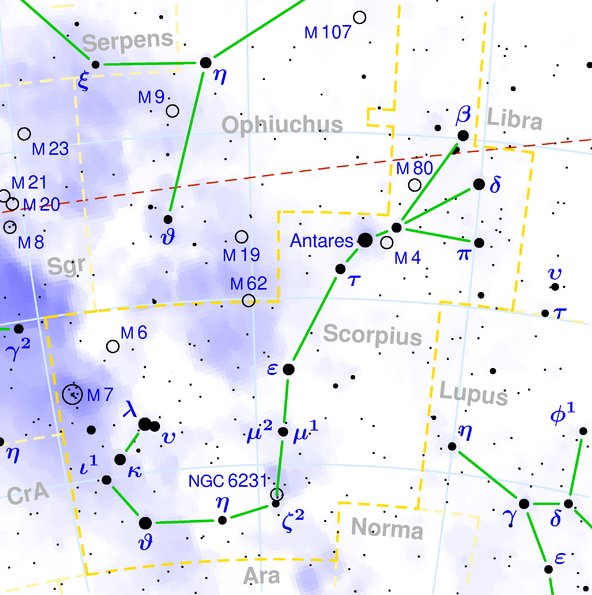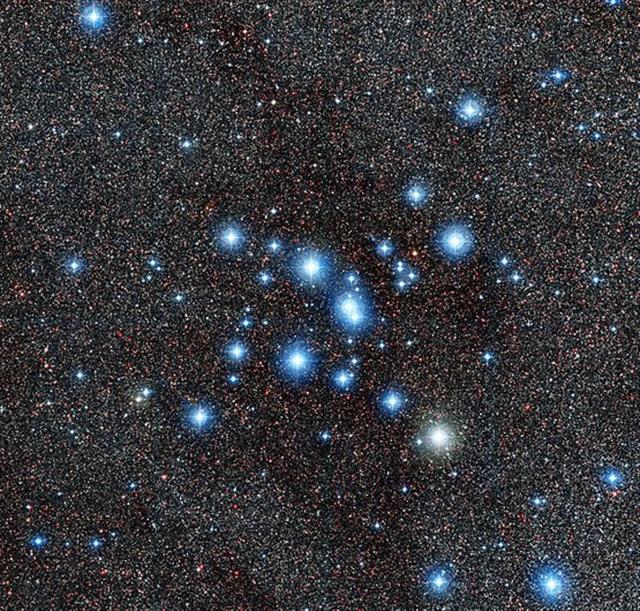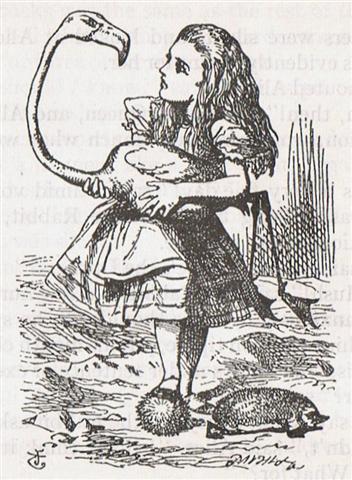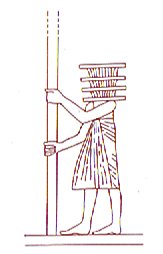R (Small
Washington Tablet)
16. It was all very natural
and easy to understand for everyone. But it was also very
complicated because nothing remained still.
We have to rely also on what words
had been chosen. For instance:
... The life-force of the earth is water. God
moulded the earth with water. Blood too he made out of water.
Even in a stone there is this force, for there is moisture in
everything. But if Nummo is water, it also produces copper. When
the sky is overcast, the sun's rays may be seen materializing on
the misty horizon. These rays, excreted by the spirits, are of
copper and are light. They are water too, because they uphold
the earth's moisture as it rises. The Pair excrete light,
because they are also light'
...
'The sun's rays,' he went on, 'are fire and the Nummo's
excrement. It is the rays which give the sun its strength. It is
the Nummo who gives life to this star, for the sun is in some
sort a star.' It was difficult to get him to explain what he
meant by this obscure statement. The
Nazarene made more than
one fruitless effort to understand this part of the cosmogony;
he could not discover any chink or crack through which to
apprehend its meaning. He was moreover confronted with
identifications which no European, that is, no average rational
European, could admit. He felt himself humiliated, though not
disagreeably so, at finding that his informant regarded fire and
water as complementary, and not as opposites. The rays of light
and heat draw the water up, and also cause it to descend again
in the form of rain. That is all to the good.
The movement created by this coming and going
is a good thing. By means of the rays the Nummo draws out, and
gives back the life-force. This movement indeed makes life ...
We can hardly read the above without stopping to consider why
'the Nazarene' was the word chosen. But what is odd will stand
out and be noticed. And possibly it was a reference to the star
ι Scorpii.


Two days later was the Ptolemy Cluster (M7).

And once again we
have to stop and think.
 |
 |
 |
 |
 |
|
Aa8-55 |
Aa8-56 |
Aa8-57 |
Aa8-58 (→ 8 * 58 =
464) |
Aa8-59 |
| ki te henua - ki te
ragi |
kua heu ia - kua rere
ki te pepe |
mai tae ia ki te nuku
- honu |
kua vero ia |
ki te honu e kau te
honu |
|
Sept 21
(264) |
ZANIA (η
Virginis)
GIENAH
(γ Corvi)
Equinox |
*186 |
*4 + *183
→ *227 - *41
+ *1 |
*188
Sept 25 |
|
3 days of cold food |
|
Pepe.
1. A sketch. 2. Bench, chair, couch, seat,
sofa, saddle; here pepe, mau pepe, to
saddle; noho pepe, a tabouret. Pepepepe,
bedstead. 3. Pau.: butterfly. Ta.: pepe, id. Mq.:
pepe, id. Sa.: pepe, id. Ma.: pepe,
a moth; pepererau, fin, Mgv.: pererau,
wing. Ta.: pereraru, id. Ma.: parirau,
id. Harepepe, kelp. Here pepe, to saddle.
Churchill. Sa.: pepe, a butterfly, a moth, to
flutter about. Nukuoro, Fu., Niuē,
Uvea, Fotuna, Nuguria, Ta., Mq.: pepe,
a butterfly. Ma.: pepe,
a grup, a moth; pepepepe,
a butterfly; pepeatua,
a species of butterfly. To.: bebe,
a butterfly. Vi.: mbèbè,
a butterfly. Rotumā: pep,
id. Churchill 2. Mq.: Pepepepe, low, flat.
Ha.: pepepe, id. Churchill. Kau.
To move one's feet (walking or swimming).
Vero
To throw, to hurl (a lance, a spear). This word was also
used with the particle kua preposed: koía kua
vero i te matá, he is the one who threw the obsidian
[weapon]. Verovero, to throw, to hurl repeatedly,
quickly (iterative of vero). Vanaga. 1. Arrow,
dart, harpoon, lance, spear, nail, to lacerate, to
transpierce (veo). P Mgv.: vero, to dart,
to throw a lance, the tail; verovero, ray, beam,
tentacle. Mq.: veó, dart, lance, harpoon, tail,
horn. Ta.: vero, dart, lance. 2. To turn over
face down. 3. Ta.: verovero, to twinkle like the
stars. Ha.: welowelo, the light of a firebrand
thrown into the air. 4. Mq.: veo, tenth month of
the lunar year. Ha.: welo, a month (about April).
Churchill. Sa.: velo, to cast a spear or dart, to
spear. To.: velo, to dart. Fu.: velo,
velosi, to lance. Uvea: velo, to cast;
impulse, incitement. Niuē:
velo, to
throw a spear or dart. Ma.: wero,
to stab, to pierce, to spear. Ta.: vero,
to dart or throw a spear. Mg.: vero,
to pierce, to lance. Mgv.: vero,
to lance, to throw a spear. Mq.: veo,
to lance, to throw a spear. Churchill 2. |
 |
 |
 |
 |
 |
 |
|
Aa8-60 |
Aa8-61 (1310) |
Aa8-62 |
Aa8-63 |
Aa8-64 |
Aa8-65 (1314) |
| e kua noho ma to ihe -
eko te honu |
nuku |
ma te mahora |
kua honu ia |
kua mata hihi rarua
mai |
ki te honu |
|
*189 |
Sept 27
(270)
*190 |
PORRIMA (γ) |
*192 |
*193 |
Oct 1 (274)
→
354 - 80 |
|
Mahora. Mgv.: to spread, to
stretch out, level. Ta.: mahora, to be spread
out, level. Mq.: mahoa, to spread out, to
display, level. Sa.: mafola, to be spread out.
Ma.: mahora, id. Churchill.
Nuku. 1. Pau.:
nuka, crowd, throng. Ta.: nuú, army,
fleet. Mg.: nuku, a host, army. 2. Mgv.: nuku,
land, country, place. Sa.: nu'u, district,
territory, island. Churchill |
The word nuku chosen by Metoro might be related to the
name for the Egyptian goddess of the night:
In English night, in Swedish natt - always
necessary to end with -t, because that meant female.
In Polynesian there has to be a vowel at the end of a word and we could
therefore expect nutu.
But for the Polynesian ear there was hardly much difference
between the sound of tu and that of ku.
|
... The letters of the Hawaiian
alphabet were established in 1826 by a committee of
missionaries who used the letters to represent the
sounds as they heard them. At this time, the change
from t to k had begun on the island of
Hawai'i but had not reached Kauai
where t was used until comparatively recent
times. Colonel Spaulding, from the reports to the
American Board of Missions in Boston, prepared a
paper read before the Hawaiian Historical Society in
1930 in which he showed how the alphabet was
compiled. The committee of nine missionaries took
various letters in turn and voted on them. The final
report, facetiously headed 'Report of the Committee
of Health on the state of the Hawaiian language',
set forth its conclusions in terms to justify the
name assumed by the committee.
The greatest difficulty was
experienced in choosing between l and r,
k and t, and w and v.
'K
is deemed of sufficent capacity to perform its own
functions and that of its counterpart T.
L though two pills have been given to expel it
is to remain to do its own office and that of its
yoke fellow R.
R though closely connected with the vitals is
expelled by five or six votes or expellants, though
nearly the same quantity of preservatives has been
applied.
T though claiming rights as a native member has
suffered amputation by the knife and saw of the
majority.
V, a contigous member and claiming similar
rights, has suffered the same fate, and a gentle
[illegible] has been applied to dry the wound of
both.'
Thus the
committe of health experts chose l, k,
and w, but as r, t, and v
are the consonants used in Tahiti, whence the
Hawaiians came, I have a feeling that the purgatives
and the knife were applied to the wrong patient in
each pair. A Polynesian kinswoman of mine asked, as
I was leaving the Bishop Museum, 'Hele 'oe i ke
kaona?' (Are you going to the kaona?).
'What is kaona?' I asked, though I knew quite
well. 'Town', she replied. 'That is how we say it in
Hawaiian.' 'Why don't you say taone?' I
asked. 'That is the way the Maoris say it and
taone is nearer in sound to town than kaona.'
'How can I', she replied, 'when there is no t
in the Hawaiian alphabet?' ...
... To complicate matters, the sound 'k' is
tending to disappear:
In
certain of these languages a somewhat modern impulse
has caused the dropping of k. This is
strongly marked in Samoa; it is found in the
Marquesas. In Samoe the k has vanished so
recently - let it be understood that the reference
is to the surd palatal mute and not to the kappation
of t which is now conquering modern Samoan as
it has succeeded in conquering Hawaiian - the k
has so lately dropped out that it actually leaves an
audible hole in the word, the vowels remain disjunct
from on either side of the gap, crasis does not take
place.
In the
Samoan alphabetical system the place of the vanished
k is taken by the inverted comma; thus
fa‘a is the modern form of a preceding faka
and is pronounced the same in every particular
except that the k has gone away. The choice
of the character is governed in this case also by
typographical convenience; as the comma represents
the briefest breath-pause in the continuing
sentence, so the comma inverted might logically
represent this infinitesimal but positive
breath-pause in the continuity of the word. The sign
is in but rare other use; the possibility of the
need arising in Samoan composition to mark the
opening of a quotation within a quotation seemed,
and very reasonably, negligible.
In the
Marquesas the type supplies represented the
provision of the common French chapel, which in this
particular happens to differ from the English in the
important detail that the marks of quotation line at
the foot of the type instead of at the top and are
therefore less practicable for such employment in
representing the absent k. But the French
fonts must carry a complete supply of accented
vowels, a waste provision in the Pacific where the
seldom-varied penult accent is almost autographic.
The acutely accented type of these otherwise useless
characters have been employed by Bishop Dordillon to
represent vowels from before which consonants have
dropped away. We should not fail to note that he is
by no means accurate in such employment of the
diacritical mark; in my collation herewith I have
not assumed to correct his dictionary record, even
though the compared material shows that no loss of
consonant has taken place ... |
We can
compare with pito (navel) and piko (curved) as in
Hanga Piko:
... Freeman describres the dualistic
cosmology of the Pythagorean school (-5th century), embodied in
a table of ten pairs of opposites. On one side there was the
limited, the odd, the one, the right, the male, the good,
motion, light, square and straight. On the other side there was
the unlimited, the even, the
many, the left, the female, the bad, rest, darkness, oblong
and curved ...
And, furthermore, once it had been clear that Ku (the War God,
the planet Mars, the Prince) stood straight up at spring equinox
... It must be admitted, however, that the
task of raising the sky was not always a long and arduous one.
In the New Hebrides of Melanesia the sky was formerly so low
overhead that a woman who was pounding roots in a mortar
happened to strike the sky with her pestle. Greatly annoyed at
the interruption she looked up and cried angrily, 'Go
on up higher!' Whereat the sky meekly obeyed her ...
it should be obvious that
Nu-ku was the corresponding female at autumn equinox.
Here began the many sources of light in the night, and these were
indeed
very
crowded (nuku).
I have named a glyph type without arms nuku:
|
 |
 |
|
nuku |
Sept 27
(270) |
3 great feathers on top of the head could have been intended to
induce the calculation 3 * 9(0) = 27(0)
And legs were necessary for swimming safely:.
|












